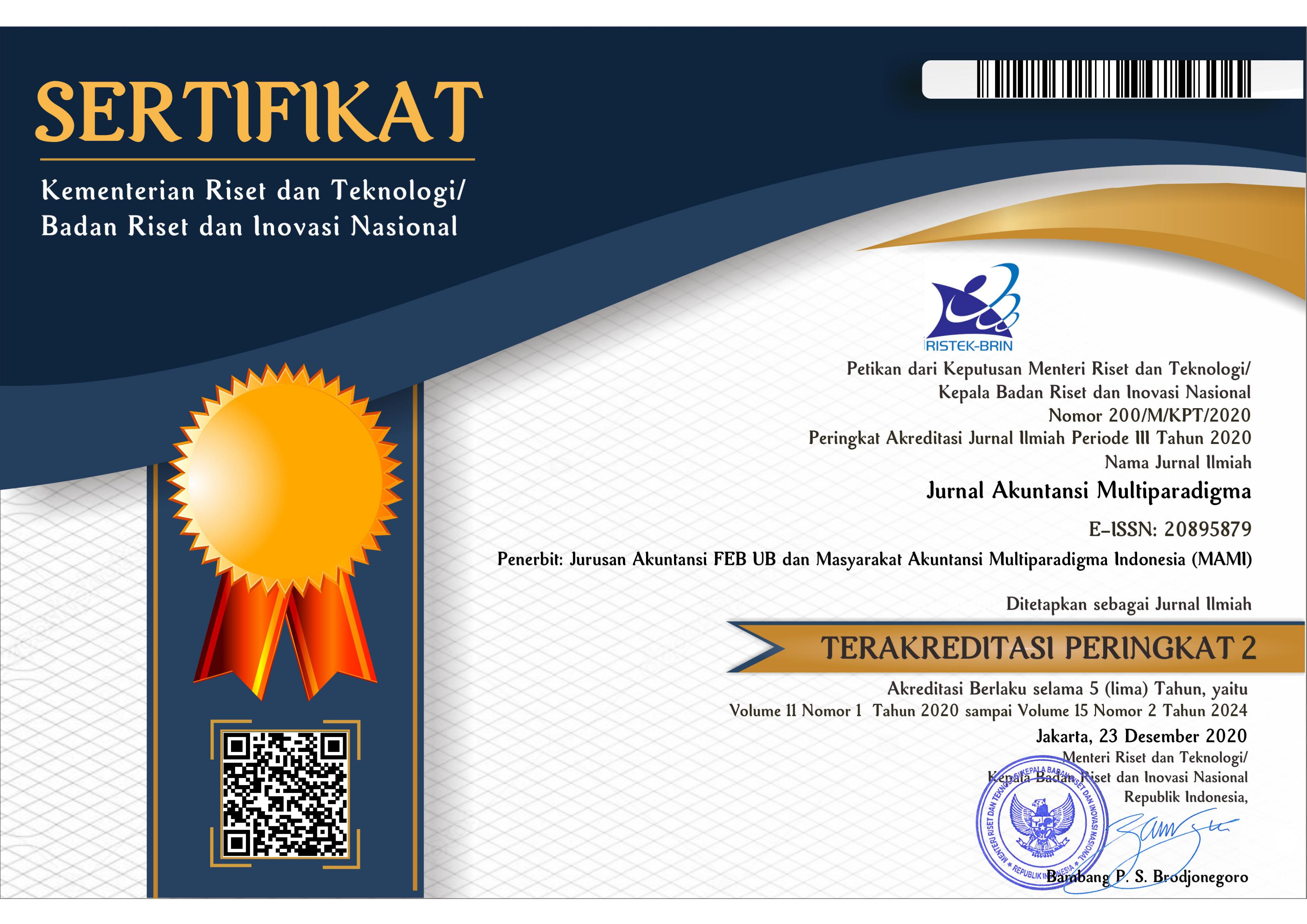PERAN ALOKASI BONUS DAN PEMAHAMAN BALANCED SCORECARD DALAM PEMILIHAN PROYEK INVESTASI
Abstract
Abstrak: Peran Alokasi Bonus dan Pemahaman Balanced Scorecard dalam Pemilihan Proyek Investasi. Penelitian ini mencoba untuk menelaah peran balanced scorecard sebagai alat untuk membantu dalam pengambilan keputusan investasi. Penelitian ini menggunakan metode controlled laboratory experiment dengan sejumlah mahasiswa pascasarjana akuntansi dan manajemen sebagai partisipan. Pengujian statistik pada data penelitian menunjukkan bahwa partisipan yang telah diberi pemahaman balanced scorecard cenderung memilih proyek yang lebih berorientasi pada keuntungan jangka panjang. Oleh karena itu pelatihan mengenai konsep dan teknik penugasan penting untuk diberikan. Selain itu, manajemen harus membuat dasar alokasi bonus yang tepat untuk meningkatkan kinerja karyawan.
Abstract: The Role of Bonus Allocation and Understanding of the Balanced Scorecard in the Selection of Investment Projects. This research attempts to examine the role of the balanced scorecard as a tool to assist in making investment decisions. This research uses controlled laboratory experiment method with a number of accounting and management postgraduate students as participants. Statistical testing on research data shows that participants who have been given a balanced scorecard understanding tend to choose projects that are more oriented to long-term benefits. Therefore training assignment concepts and techniques are important to be given. In addition, management must make the right allocation base to improve employee performance.
Keywords
Full Text:
PDFReferences
Agusti, R., & Pertiwi, N. P. (2013). Pengaruh Kompetensi, Independensi dan Profesionalisme Terhadap Kualitas Audit (Studi Empiris Pada Kantor Akuntan Publik Se Sumatera). Jurnal Ekonomi, 21(3), 1–13.
Alfandi, D. A. M., & Alkahsawneh, D. M. S. (2014). The Role of the Incentives and Reward System in Enhancing Employee’s Performance: A Case of Jordanian Travel and Tourism Institutions. International Journal of Academic Research in Business and Social Sciences, 4(4), 326–341. https://doi.org/10.6007/IJARBSS/v4-i4/788
Anderson, D. M., & Edwards, B. C. (2015). Unfulfilled Promise: Laboratory Experiments in Public Management Research. Public Management Review, 17(10), 1518-1542. https://doi.org/10.1080/14719037.2014.943272
Apostolopoulos, N., & Liargovas, P. (2016). Regional Parameters and Solar Energy Enterprises: Purposive Sampling and Group AHP Approach. International Journal of Energy Sector Management, 10(1), 19-37. https://doi.org/10.1108/IJESM-11-2014-0009
Argüden, Y. (2013). Right reward for Right Performance: Aligning Executive Compensation with Good Governance. International Journal of Disclosure and Governance, 10(2), 122-134. https://doi.org/10.1057/jdg.2013.14
Bear, J. B., & Glick, P. (2017). Breadwinner Bonus and Caregiver Penalty in Workplace Rewards for Men and Women. Social Psychological and Personality Science, 8(7), 780–788. https://doi.org/10.1177/1948550616683016
Benson, A. M., & Sajjadiani, S. (2018). Are Bonus Pools Driven by Their Incentive Effects? Evidence from Fluctuations in Gainsharing Incentives. ILR Review, 71(3), 567–599. https://doi.org/10.1177/0019793917726066
Bind, M. A. C., & Rubin, D. B. (2017). Bridging Observational Studies and Randomized Experiments by Embedding the Former in the Latter. Statistical Methods in Medical Research, 1(1), 1-21. https://doi.org/10.1177/0962280217740609
Brink, A. G., & Rankin, F. W. (2013). The Effects of Risk Preference and Loss Aversion on Individual Behavior under Bonus, Penalty, and Combined Contract Frames. Behavioral Research in Accounting, 25(2), 145-170. https://doi.org/10.2308/bria-50408
Campbell, D., Datar, S. M., Kulp, S. L., & Narayanan, V. G. (2015). Testing Strategy with Multiple Performance Measures: Evidence from a Balanced Scorecard at Store24. Journal of Management Accounting Research, 27(2), 39-65. https://doi.org/10.2308/jmar-51209
Campion, E. D., Campion, M. C., & Campion, M. A. (2017). Best Practices in Incentive Compensation Bonus Administration Based on Research and Professional Advice. Compensation & Benefits Review, 49(3), 123–134. https://doi.org/10.1177/0886368718777335
Cardinaels, E. (2008). The Interplay between Cost Accounting Knowledge and Presentation Formats in Cost-Based Decision-Making. Accounting, Organizations and Society, 33(6), 582–602. https://doi.org/10.1016/j.aos.2007.06.003
Cardinaels, E., & Veen-Dirks, P. M. G. V. (2010). Financial versus Non-Financial Information: The Impact of Information Organization and Presentation in a Balanced Scorecard. Accounting, Organizations and Society, 35(6), 565–578. https://doi.org/10.1016/j.aos.2010.05.003
Carmona, S., Iyer, G., & Reckers, P. M. J. (2011). The Impact of Strategy Communications, Incentives and National Culture on Balanced Scorecard Implementation. Advances in Accounting, 27(1), 62–74. https://doi.org/10.1016/j.adiac.2011.01.004
Chen, Y., Jermias, J., & Panggabean, T. (2016). The Role of Visual Attention in the Managerial Judgment of Balanced‐Scorecard Performance Evaluation: Insights from Using an Eye‐Tracking Device. Journal of Accounting Research, 54(1), 113-146. https://doi.org/10.1111/1475-679X.12102
Chen, C. X., Matsumura, E. M., Shin, J. Y., & Wu, S. Y. C. (2015). The Effect of Competition Intensity and Competition Type on the Use of Customer Satisfaction Measures in Executive Annual Bonus Contracts. The Accounting Review, 90(1), 229-263. https://doi.org/10.2308/accr-50870
Cheng, M. M., & Humphreys, K. A. (2012). The Differential Improvement Effects of the Strategy Map and Scorecard Perspectives on Managers' Strategic Judgments. The Accounting Review, 87(2), 899-924. https://doi.org/10.2308/accr-10212
Choi, J. W. (2014). Can Offering a Signing Bonus Motivate Effort? Experimental Evidence of the Moderating Effects of Labor Market Competition. The Accounting Review, 89(2), 545-570. https://doi.org/10.2308/accr-50641
Chopra, M., Gupta, V., & Chhabra, B. (2017). Strategic Management Using Balanced Scorecard—A Case Study on Tata Power. South Asian Journal of Business and Management Cases, 6(2), 176–190. https://doi.org/10.1177/2277977917730446
Danish, R. Q., & Usman, A. (2010). Impact of Reward and Recognition on Job Satisfaction and Motivation: An Empirical Study from Pakistan. International Journal of Business and Management, 5(2), 159–167. https://doi.org/10.5539/ijbm.v5n2p159
Day, J. W., Holladay, C. L., Johnson, S. K., & Barron, L. G. (2014). Organizational Rewards: Considering Employee Need in Allocation. Personnel Review, 43(1), 74-95. https://doi.org/10.1108/PR-09-2012-0156
Dewi, K., & Fuadah, L. (2017). Praktik Kerja Lapangan dalam Pembelajaran Akuntansi Manajemen. Jurnal Akuntansi Multiparadigma, 8(2), 382-398. https://doi.org/10.18202/jamal.2017.08.7061
Eisenhardt, K. M. (1989). Agency Theory: An Assesment and Review. Academy of Management Review, 14(1), 57–74. https://doi.org/ 10.2307/258191
Hartono, J. (2004). Metodologi Penelitian Bisnis: Salah Kaprah dan Pengalaman-Pengalaman. Yogyakarta: BPFE Yogyakarta.
Hidayat, S., Maarif, M., & Najib, M. (2017). Determination of Key Performance Indicator with Balanced Scorecard Approach in Public Sector. Jurnal Aplikasi Manajemen, 15(2), 290 - 300. httpa://doi.org/10.21776/ub.jam.2017.015.02.13
Hladchenko, M. (2015). Balanced Scorecard – A Strategic Management System of the Higher Education Institution. International Journal of Educational Management, 296(2), 167-176. https://doi.org/10.1108/IJEM-11-2013-0164
Johnson, E. N., Reckers, P. M. J., & Bartlett, G. D. (2014). Influences of Timeline and Perceived Strategy Effectiveness on Balanced Scorecard Performance Evaluation Judgments. Journal of Management Accounting Research, 26(1), 165-184. https://doi.org/10.2308/jmar-50639
Humphreys, K. A., & Trotman, K. T. (2011). The Balanced Scorecard: The Effect of Strategy Information on Performance Evaluation Judgments. Journal of Management Accounting, 23(1), 81-98. https://doi.org/10.2308/jmar-10085
Kaplan, R. S., & Norton, D. P. (1992). The Balanced Scorecard--measures that Drive Performance. Harvard Business Review, 70(1), 71–79. https://doi.org/00178012
Kaplan, R. S., & Norton, D. P. (1996). Linking the Balanced Scorecard to Strategy. California Management Review, 39(1), 53–79. https://doi.org/10.2307/41165876
Kim, S., & Ng, J. (2018). Executive Bonus Contract Characteristics and Share Repurchases. The Accounting Review, 93(1), 289-316. https://doi.org/10.2308/accr-51731
Kunz, R. E., Siebert, J., & Mütterlein, J. (2016). Combining Value‐Focused Thinking and Balanced Scorecard to Improve Decision‐making in Strategic Management. Journal of Multi‐Criteria Decision Analysis, 23(5-6), 225-241. https://doi.org/10.1002/mcda.1572
Lardner, S. (2015). Effective Reward Ensures Effective Engagement. Strategic HR Review, 14(4), 131-134. https://doi.org/10.1108/SHR-06-2015-0050
Leisen, D. P. J. (2015). Dynamic Risk Taking with Bonus Schemes. Quantitative Finance, 15(9), 1583-1596. https://doi.org/10.1080/14697688.2014.969299
Lopez-Valeiras, E., Gonzalez-Sanchez, M. B. & Gomez-Conde, J. (2017). Review of Managerial Science, 10(3), 487-510. https://doi.org/10.1007/s11846-015-0165-9
Malina, M. A., & Selto, F. H. (2015). Behavioral-Economic Nudges and Performance Measurement Models. Journal of Management Accounting Research, 27(1), 27-45. https://doi.org/10.2308/jmar-50821
Mano, M. D., I., & Creaser, C. (2016). The Impact of the Balanced Scorecard in Libraries: From Performance Measurement to Strategic Management. Journal of Librarianship and Information Science, 48(2), 191–208. https://doi.org/10.1177/0961000614558078
Margetts, H. Z. (2011). Experiments for Public Management Research. Public Management Review, 13(2), 189-208. https://doi.org/10.1080/14719037.2010.532970
Massingham, P. R., & Tam, L. (2015). The Relationship between Human Capital, Value Creation and Employee Reward. Journal of Intellectual Capital, 16(2), 390-418. https://doi.org/10.1108/JIC-06-2014-0075
Mendes, P., Nunes, L. M., & Teixeira, M. R. (2014). Quantitative Performance Targets by Using Balanced Scorecard System: Application to Waste Management and Public Administration. Waste Management & Research, 32(9), 927–936. https://doi.org/10.1177/0734242X14540977
Mishra, A., & Mishra, H. (2011). The Influence of Price Discount versus Bonus Pack on the Preference for Virtue and Vice Foods. Journal of Marketing Research, 48(1), 196–206. https://doi.org/10.1509/jmkr.48.1.196
Mortensen, T., Fisher, R., & Wines, G. (2012). Students as Surrogates for Practicing Accountants: Further Evidence. Accounting Forum, 36(4), 251–265. https://doi.org/10.1016/j.accfor.2012.06.003
Nugraha, G., Subroto, B., & Rahman, A. (2014). Peran Pendekatan Antar Disiplin terhadap Penilaian Risiko Penyalahgunaan Aset. Jurnal Akuntansi Multiparadigma, 4(2), 238-256. https://doi.org/10.18202/jamal.2013.08.7195
Park, S. B., Chung, N., & Woo, S. C. (2013). Do Reward Programs Build Loyalty to Restaurants? The Moderating Effect of Long‐Term Orientation on the Timing and Types of Rewards. Managing Service Quality: An International Journal, 23(3), 225-244. https://doi.org/10.1108/09604521311312246
Perkins, M., Grey, A., & Remmers, H. (2014). What do We Really Mean by “Balanced Scorecard”? International Journal of Productivity and Performance Management, 63(2), 148-169. https://doi.org/10.1108/IJPPM-11-2012-0127
Porporato, M. (2010). Balanced Scorecard Design Preferences According to Subjects’ Knowledge and Expertise. International Journal of Behavioural Accounting and Finance, 1(3), 182. https://doi.org/10.1504/IJBAF.2010.031315
Putri, I. G. A. M. A. D (2012). Pengaruh Budaya Organisasi terhadap Kinerja dalam Perspektif Balanced Scorecard. Jurnal Akuntansi Multiparadigma, 3(3), 462-470. httsp://doi.org/10.18202/jamal.2012.12.7175
Reda, N. W. (2017). Balanced Scorecard in Higher Education Institutions: Congruence and Roles to Quality Assurance Practices. Quality Assurance in Education, 25(4), 489-499. https://doi.org/10.1108/QAE-09-2015-0038
Rotchanakitumnuai, S. (2013). Assessment of E‐Procurement Auction with a Balanced Scorecard. International Journal of Physical Distribution & Logistics Management, 43(1), 39-53. https://doi.org/10.1108/09600031311293246
San, O. T., Theen, Y. M., & Heng, T. B. (2012). The Reward Strategy and Performance Measurement (Evidence from Malaysian Insurance Companies). International Journal of Business, Humanities and Technology, 2(1), 211–223.
Sutedjo, A. S., & Mangkunegara, A. P. (2013). Pengaruh Kompetensi dan Motivasi Kerja terhadap Kinerja Karyawan di PT. Inti Kebun Sejahtera. Bisnis dan Manajemen, 5(2), 120-129. https://doi.org/10.26740/bisma.v5n2.p120-129
Tout, S., Ghazzawi, K., Nemar, S. E., & Choughari, R. (2014). The Major Role Accountants Play in the Decision Making Process. International Journal of Finance and Accounting, 3(5), 310–315. https://doi.org/10.5923/j.ijfa.20140305.05
Waal, A. D., & Jansen, P. (2013). The Bonus as Hygiene Factor: The Role of Reward Systems in the High Performance Organization. Evidence-based HRM: A Global Forum for Empirical Scholarship, 1(1), 41-59. https://doi.org/10.1108/20493981311318601
Wang, Y., & Chee, C. S. (2012). Density Estimation Using Non-Parametric and Semi-Parametric Mixtures. Statistical Modelling, 12(1), 67–92. https://doi.org/10.1177/1471082X1001200104
Watts, R. L., & Zimmerman, J. L. (1978). Towards a Positive Theory of the Determination of Accounting Standards. The Accounting Review, 53(1), 112–134.
Wynder, M. (2010). Chemico: Evaluating Performance Based on the Balanced Scorecard. Journal of Accounting Education, 28(3–4), 221–236. https://doi.org/10.1016/j.jaccedu.2011.03.006
Varkkey, B., Korde, R., & Wadhwaniya, S. (2017). Changes in the Executive Bonus Payment Patterns in India Between 2008 - 2016: Some Evidences. Compensation & Benefits Review, 49(2), 63–86. https://doi.org/10.1177/0886368718757095
Wood, D., Thornley, B., & Grace, K. (2013). Institutional Impact Investing: Practice and Policy. Journal of Sustainable Finance & Investment, 3(2), 75-94. https://doi.org/10.1080/20430795.2013.776256
Yu, I. T. (2013). A Modification of the Box–Meyer Method for Finding the Active Factors in Screening Experiments. Journal of Applied Statistics, 40(5), 972-984. https://doi.org/10.1080/02664763.2012.761181
Zhang, X., Xu, J., & He, J. (2013). Assessing Non-Inferiority with Time-to-Event Data via the Method of Non-Parametric Covariance. Statistical Methods in Medical Research, 22(3), 346–360. https://doi.org/10.1177/0962280211402261
DOI: http://dx.doi.org/10.18202/jamal.2018.04.9026
Refbacks
- There are currently no refbacks.
Copyright (c) 2018 Meutia Faizza, Bambang Purnomosidhi, Zaki Baridwan

This work is licensed under a Creative Commons Attribution-NonCommercial 4.0 International License.

















